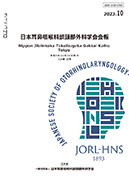Volume 126, Issue 10
Displaying 1-13 of 13 articles from this issue
- |<
- <
- 1
- >
- >|
Review article
-
Article type: review-article
2023 Volume 126 Issue 10 Pages 1107-1111
Published: October 20, 2023
Released on J-STAGE: November 01, 2023
Download PDF (806K) -
Article type: review-article
2023 Volume 126 Issue 10 Pages 1112-1119
Published: October 20, 2023
Released on J-STAGE: November 01, 2023
Download PDF (3004K) -
Article type: review-article
2023 Volume 126 Issue 10 Pages 1120-1124
Published: October 20, 2023
Released on J-STAGE: November 01, 2023
Download PDF (5631K)
Original article
-
Subject area: Original article
2023 Volume 126 Issue 10 Pages 1125-1133
Published: October 20, 2023
Released on J-STAGE: November 01, 2023
Download PDF (712K) -
Article type: Original article
2023 Volume 126 Issue 10 Pages 1134-1141
Published: October 20, 2023
Released on J-STAGE: November 01, 2023
Download PDF (685K) -
Article type: case-report
2023 Volume 126 Issue 10 Pages 1142-1147
Published: October 20, 2023
Released on J-STAGE: November 01, 2023
Download PDF (1108K) -
2023 Volume 126 Issue 10 Pages 1148-1153
Published: October 20, 2023
Released on J-STAGE: November 01, 2023
Download PDF (333K)
Final Lecture
-
2023 Volume 126 Issue 10 Pages 1154-1162
Published: October 20, 2023
Released on J-STAGE: November 01, 2023
Download PDF (1309K)
Training lecture
-
2023 Volume 126 Issue 10 Pages 1165-1169
Published: October 20, 2023
Released on J-STAGE: November 01, 2023
Download PDF (1364K)
Skill up lecture
-
2023 Volume 126 Issue 10 Pages 1170-1173
Published: October 20, 2023
Released on J-STAGE: November 01, 2023
Download PDF (422K)
ANL Secondary Publication
-
2023 Volume 126 Issue 10 Pages 1174-1175
Published: October 20, 2023
Released on J-STAGE: November 01, 2023
Download PDF (262K) -
2023 Volume 126 Issue 10 Pages 1176-1178
Published: October 20, 2023
Released on J-STAGE: November 01, 2023
Download PDF (391K) -
2023 Volume 126 Issue 10 Pages 1179-1180
Published: October 20, 2023
Released on J-STAGE: November 01, 2023
Download PDF (420K)
- |<
- <
- 1
- >
- >|
